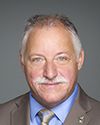Good morning, Madam Chair and members of the committee.
My name is Albert Lo. I am the chairperson of the Canadian Race Relations Foundation. I am accompanied by Rubin Friedman.
Mr. Friedman is a member of the foundation's board of directors and chair of our governance committee.
Incidentally, he once held senior positions in multiculturalism and acted as the director of the Japanese-Canadian Redress Secretariat with the Government of Canada.
Madam Chair, it is an honour for me to serve in this capacity as chair. It is my 30th year in the area of human rights, employment equity, and multiculturalism. I was first exposed to this arena when I was with the federal public service through Canada Mortgage and Housing, where for I worked for almost 20 years.
The Canadian Race Relations Foundation was created as a non-agent crown corporation as part of the Japanese-Canadian Redress Agreement of 1988, operating on income generated from a $24-million endowment, half of which was contributed by the Japanese Canadian community. The foundation has a very large mandate to help eliminate racism and racial discrimination across Canada. We have also received limited amounts of funding from governments for specific projects. We are mindful of the past injustices and negative instances, while building on our precious heritage of accommodating differences. Our vision is to be the leading voice and agent of change in pursuit of our mandate and the promotion of inclusion, belonging, and a mutuality of citizenship rights and responsibilities.
We focus on advancing understanding and development of approaches to improving race relations and eliminating racial discrimination; strengthening Canadian identity as it refers to the democratic principles of inherent human dignity, equality, fairness, and justice; expanding our clearinghouse and initiatives to inform national policies and public conversations; and facilitating and stimulating the discussions and further research on race relations.
We target our work to creating and nurturing an inclusive society based on equality, mutual respect, and human dignity across religious, ethnic, linguistic, and racial lines.
A key antidote to racism and racial discrimination is the holistic approach to promoting these shared values based on our Constitution and democracy, along with an awareness of the negative consequences of prejudice and discrimination for the economic and social well-being of all Canadians.
Madam Chair, these elements inform and shape our overall strategy. The foundation's initiatives are all designed accordingly.
Now I would like to mention a number of initiatives that the foundation has undertaken.
The Capturing the Pulse of the Nation initiative is an annual survey, in co-operation with the Association for Canadian Studies. For instance, we commissioned a research on attitudes toward aboriginal peoples in Canada, which sounded a warning in 2013.
The Directions digital publication is an electronic journal.
Our clearinghouse function is a valuable and growing collection of well over 4,000 searchable digital records of resources relating to race relations.
We also have the eRACE virtual book club.
The digital initiative 150 Stories, which is part of the Our Canada project, publishes one personal story per week for 150 weeks, in celebration of Canada's upcoming sesquicentennial, paying tribute to Canada's diversity, democratic principles, and multiculturalism through the experiences of individuals, organizations, and historic events.
We also conducted The Urban Agenda round tables in partnership with many other organizations.
We have held nine Living Together symposia so far across Canada on research and best practices in shared values. The symposia were built upon community consultations between November 2014 and June 2015: first nations, Métis, and Inuit consultation in Sudbury; francophone consultation in Montreal; and faith leaders consultation in Ottawa.
We are conducting 24 workshops in 19 cities across Canada in the last fiscal year, 2015-16, and 23 have been completed so far.
We also host a biennial national conference and awards of excellence.
The Canada Lecture is an annual lecture that invites accomplished Canadians to raise awareness and understanding of critical issues. This year we have done it by linking up four universities across Canada.
We continue to involve ourselves in the Metropolis conference.
In terms of engaging youth, Voices into Action is one particular initiative. We also launched a youth video challenge. Youth Café Canada is being planned for youth and community leaders to explore ideas to foster positive race relations.



